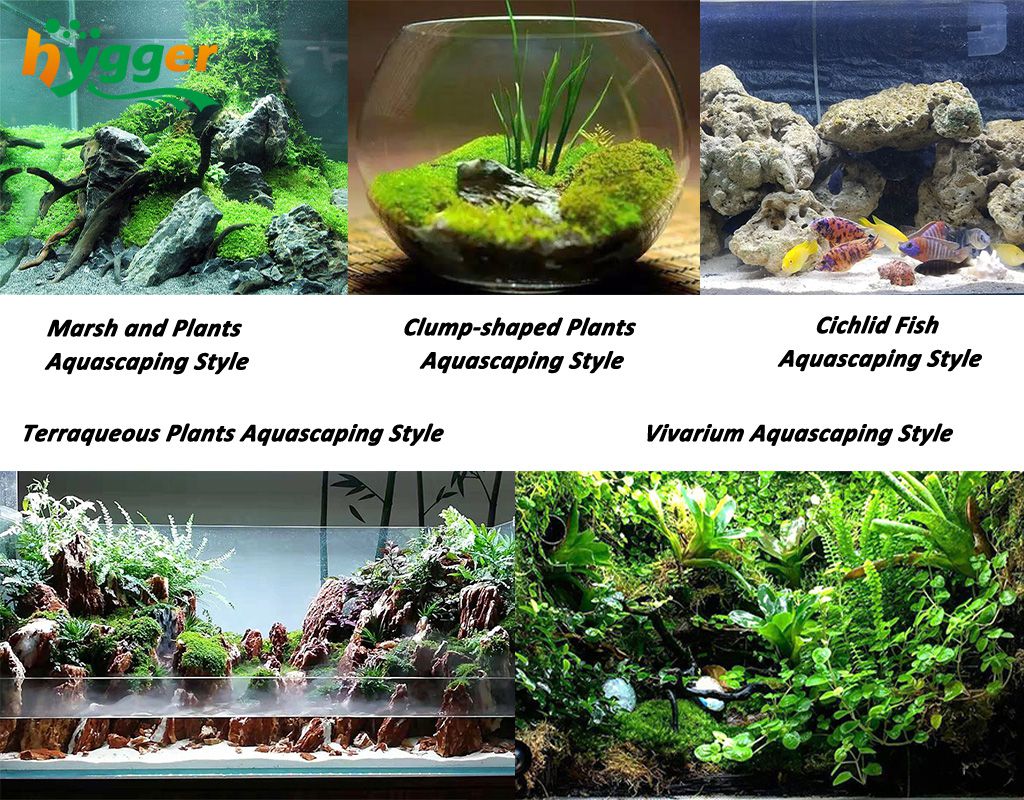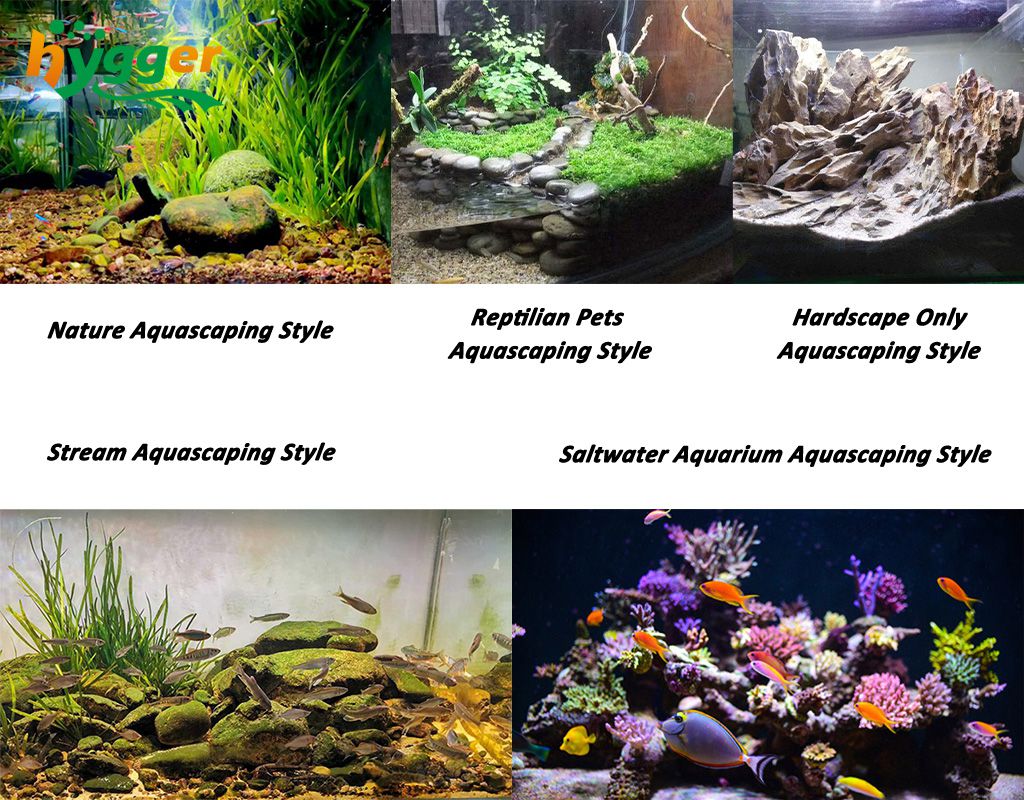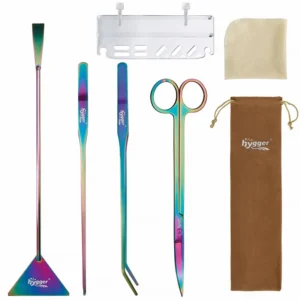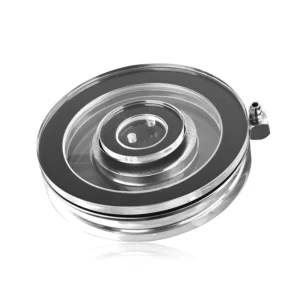Hey, guys, after reading the Aquascape Aquarium and the Golden Ratio Part One, can not wait to learn more about aquascaping. Now, Part Two is coming. Today’s article will share the protagonist in aquarium aquascape and the other 10 aquascaping styles. Without further ado, let’s get started right away.
Content Table
Protagonist in Aquarium Aquascape
From the perspective of the protagonist in aquarium aquascape, there are mainly five styles, including fish-oriented and rocks-supplementary, fish-oriented and plants-supplementary, plants-oriented and fish-supplementary, integration of fish and landscape, and three-dimensional style. Following this part, we will walk you through something you need to know about aquarium aquascape styles. So let’s dive in.
1. Fish-oriented and rocks-supplementary
Featuring diverse shapes and sizes of live rocks, a mountain landscape will be formed in your aquarium, including styles of plates, peaks, stone forests, cliffs, caves, or others. However, schools of colorful and vibrant fish should be the focal point. Fish swim around the aquarium, which improves the ornamental values. Moreover, here is one tip. The rocks or other aquarium decorations should be hard but smooth, and soluble compounds free.
2. Fish-oriented and plants-supplementary
When it comes to fish-oriented and plant-supplementary styles, schooling fish should be the first choice, like neon tetras and zebrafish. And fish similar in size are the best alternative. As for the aquarium decorations, just add some aquatic plants.
3. Plants-oriented and fish-supplementary
Imagine that, the light shines on the plants, and some fish swim around the aquarium. Is there an attractive picture formed in your mind? Exactly, it is feasible to add substrate to your tank, and then plant different types of plants, including tall, relatively short, or floating ones. But you should avoid too many types. At the same time, you can introduce some small fish. They will add color to your aquarium. Nonetheless, you should pay attention to the plants’ layout. Otherwise, your aquarium will be a mess. For instance, tall plants are usually placed in the back of a tank, while short ones are in the front.
4. Integration of fish and landscape
The integration of fish and landscape style is not fish-oriented or landscape-oriented. It is just like a combination. Various fish species are introduced to the aquarium, while there are other aquarium decorations, including aquatic plants, rocks, stone, caves, wood, artificial aquarium pavilions, and others.
5. Three-dimensional style
Aquariums of three-dimensional style will take up a lot of space. The aquarium indoors should be kept space from the walls. And there are no covers around the aquarium, which allows light to penetrate the aquarium. In general, the three-dimensional style aquariums will be built in restaurants, the hall of a villa, or somewhere with enough room.
Aquascaping Styles
Before we get into the details of the most popular aquarium aquascaping styles, let’s review the aquascaping styles mentioned in Part One.
Most popular aquarium aquascaping styles |
||
| 1. The Dutch Aquascaping Style | 2. The German Aquascaping Style | 3. The Southeast Asian Aquascaping Style |
| 4. The Japanese Aquascaping Style | 5. The Chinese Taiwan Aquascaping Style | 6. The Chinese Aquascaping Style |
| 7. The African Aquascaping Style | 8. The South American Aquascaping Style | 9. The Terraqueous Plants Aquascaping Style |
| 10. The Marsh and Plants Aquascaping Style | 11. The Clump-shaped Plants Aquascaping Style | 12. The Vivarium Aquascaping Style |
| 13. The Cichlid Fish Aquascaping Style | 14. The Stream Aquascaping Style | 15. The Nature Aquascaping Style |
| 16. The Saltwater Aquarium Aquascaping Style | 17. The Reptilian Pets Aquascaping Style | 18. The Hardscape Only Aquascaping Style |
Next, we will cover the last 10 aquascaping styles in this segment.

1. The Terraqueous Plants Aquascaping Style
Generally, the rocks are placed in the back of the aquarium, and the rocks can be above the aquarium water surface. Then, it is feasible to plant aquatic plants on the substrate or rocks. On the other side, you can also divide the aquarium into two parts – the front and back. The back part can be used as a filter cell, and it is feasible to place rocks above the cell. In addition to this, you can decorate the aquarium with artificial aquarium buildings, figures, or other aquarium accessories.
2. The Marsh and Plants Aquascaping Style
The Marsh and Plants Aquascaping Style consists of herbaceous plants and marsh aquascaping, sphagnum and marsh aquascaping, as well as aquarium wood and marsh aquascaping. Specifically, the herbaceous plants and marsh aquascaping feature wetting soil and standing water. And moss and plants from the Poaceae family are used in aquascaping aquariums. Besides that, sphagnum and marsh aquascaping need sufficient water, low temperature, and nutrient supplements. And you can add some small and hardy aquatic plants. Additionally, wood and marsh aquascaping includes wood and plants. It is feasible to plant some moss on the wood. Also, other plants in the aquarium should adapt to the wetting soil.
3. The Clump-shaped Plants Aquascaping Style
The Clump-shaped Plants Aquascaping Style is ideal for offices, homes, or anywhere with limited space. A necessary tool can be a fish bowl or other available utensils. Then, knead the turfy soil with some water, and wrap it with moss. After that, add plants. Finally, give it some water.
4. The Vivarium Aquascaping Style
The Vivarium Aquascaping Style mimics the rainforest scenery. Generally, you should add an aquarium lid to maintain high humidity. Aside from that, the aquariums of the Vivarium Aquascaping Style demand lighting, temperature, oxygen level, and others. Consequently, it is best to add an aquarium light, an aquarium heater, an aquarium air pump, or other necessary aquarium equipment.
5. The Cichlid Fish Aquascaping Style
The Cichlid Fish Aquascaping Style aquariums are not difficult to set up, which mainly include cichlid fish, some aquarium decorations, and pieces of aquarium equipment. Compared with planted aquariums, they need less time to maintain. Commonly, rectangular aquariums are better alternatives. Because it makes rock and stone selections easier. And you should avoid rocks and stones with sharp edges. Or it may cause injury to fish.
Next, we will share an example. You can use white sand as a substrate. In this case, it is recommended to choose black, gray, or off-white rocks. As for the light, blue light is best. Furthermore, adding some aquatic plants is feasible.

6. The Stream Aquascaping Style
The stream Aquascaping Style aquariums also mimic the natural scenery. In general, rocks, stone, aquarium sand, or gravel are applied to create rivers or streams in the aquarium. The stones or rocks are not in the same shapes or sizes. Moreover, you can introduce some freshwater shrimp, and add some aquatic plants along the stream.
7. The Nature Aquascaping Style
The Nature Aquascaping Style aquariums take the nature aquascape scenery as the prototype. Compared with planted tanks, they are easier to build and maintain. And they are lower-cost options. Because they are not demanding lights, carbon dioxide levels, filtration systems, or others.
8. The Saltwater Aquarium Aquascaping Style
The Saltwater Aquarium Aquascaping Style aquarium may be classified into saltwater fish aquariums, soft coral aquariums, hard coral aquariums, and other types. They are varicolored and attractive.
9. The Reptilian Pets Aquascaping Style
Reptilian Pets Aquascaping Style? Yep, that sounds interesting, right? It is feasible to keep reptilian pets in aquariums, in addition to fish, shrimps, and plants. Crabs, snails, lizards, axolotls, and turtles are excellent alternatives.
10. The Hardscape Only Aquascaping Style
Just as the name implies, some are no aquatic plants in the Hardscape Only Aquascaping Style aquariums, which only consist of stones, rocks, wood, tree trunks, and other hard landscapes.
Aquascaping Aquarium
In short, no matter which aquarium aquascape style you choose, it is vital to determine the aquarium layout before starting aquascaping. For additional aquascaping styles, you can read the part one article – Aquascape Aquarium and the Golden Ratio Part One.
That’s it. Hope you will have an enjoyable aquascaping experience. Finally, thanks for taking the time.


Leave a comment